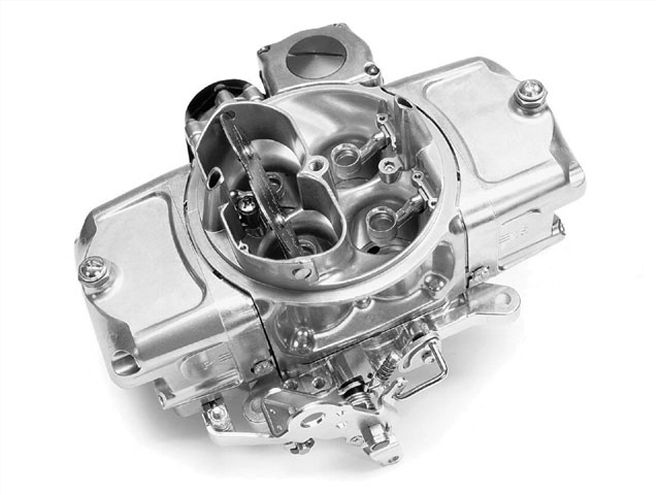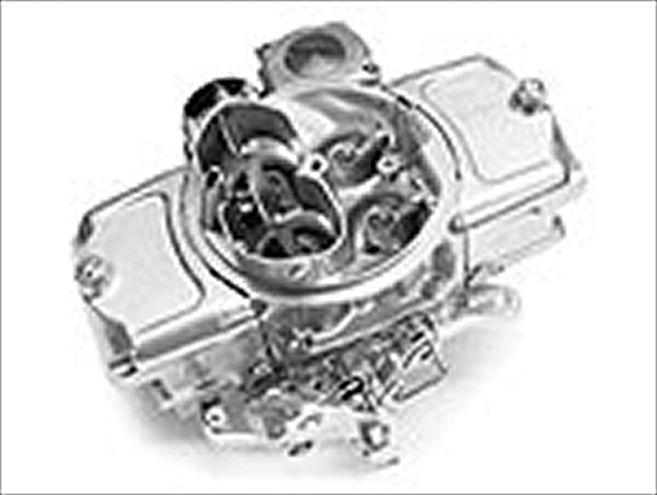


Now, we here at Mopar Muscle are all about big cubes, low track times, and nasty plumes of rubbery smoke clogging up the air, but, at the same time, our nonsensical, barbaristic shenanigans need to be tempered. While building a crazy, rip-snortin' engine isn't rocket science, it sure isn't as easy as burning toast.
Take carburetors, for example. They are basically like the nozzle attachment to a really big shop vac. The right nozzle will give you maximum concentrated airflow, while the wrong one will be too restrictive or simply not focused enough. If you bolt on a carb too restrictive, you'll be starving your engine of the necessary air/fuel mixture that it needs, and, transversely, if you slap a 1,150-cfm Holley Dominator onto your 318, you'll be drowning your small-block to death with too much anatomized air versus a properly mixed balance.
What we're looking to do is offer you a basic (the key word here is basic) guideline in choosing the proper size carburetor for a more-than-stock Mopar. For those of you who are restoring your Mo' Power, you already know what you need, the factory already did it for you. But for the rest of us who are a few fries short of a Happy Meal, this is for you.
You need to know what your engine is asking for. Meaning, what is the optimal airflow mixture needed for your specific engine? Here's how to find out. First, you need to come to grips with what kind of engine you've built: a stock/street configuration, a high-performance engine, or a purebred race engine. With that in mind, we've provided the mathematical equation to determine what cfm you will need based on 1) your engine's cubic inches (ci), 2) the maximum rpm in which ideal airflow ought to occur, and 3) the percentage of volume efficiency (ve).
ci x maximum rpm = ideal cfm 3456 ideal cfm x ve = real cfm
If this looks too much like high school algebra, let's do an example together. Let's say we have an imaginary 440 that makes its optimal power at 6,000 rpm. But the 440 is going to be used for street and strip use, making it a high-performance engine. High-performance engines use roughly 85 percent to 90 percent of its air volume intake at full throttle; stock/street engines use 80 percent to 85 percent; race engines use 90 percent to 95 percent. Engines using 100 percent or more are usually supercharged or turbocharged, and we're nowhere near that neighborhood.
So plugging in our variables, let's see how our numbers come out.
440 (ci) x 6,000 (rpm)= 764 (ideal cfm) 3456 764 (ideal cfm) x .90 (ve) = 688 cfm
What this means for us is that our imaginary street 440 Wedge requires a 688-cfm carburetor. Yet, knowing that nobody makes a 688-cfm carb, what are we to do?
Going too small strangles our engine, so that's not an option. going to a 700-cfm or 750-cfm carb is our best bet. But how much larger can we go before the engine suffers? That is ultimately based on the intended use of the engine, coupled with the driveline characteristics and weight of the vehicle.
If the vehicle is lightened for race-readiness and stocked with steep rear gears and a performance-oriented transmission, then the combination will allow leeway in the final airflow intake. A slower, heavier, street driving-bred vehicle will fall short of needing the extra cfm and, ultimately, do little good. The high-performance application will push the air volume efficiency more towards the 100-percent mark, pushing the final cfm number more towards our previous ideal cfm number. That is why Dick Landy's cross-rammed Darts were sucking in 1,560 cfm with 426 cubes, while the massive 440 Dodge Polara needed only a meager 625 cfm to push its hulk along.
Now that we've determined what cfm our motor requires, we need to choose what kind of behavior we'd like our engine to exhibit. The carburetor regulates throttle response, launch, and idle speed, making for a difficult decision. With a four-barrel carb, options are nearly endless. In keeping with our theme of boiling down selection, we've reduced this choice to two: vacuum secondaries and mechanical secondaries. due to the vast array of available intake manifolds with either standard Holley or Carter bolt patterns, the brand of carburetor you choose for your motor is solely based on 1) what look you want 2) what performance you desire, and 3) what intake you choose.
Carburetors with vacuum secondaries are usually found in stock applications. The vacuum produced by the engine sends a reading or vacuum signal to the carburetor, alerting it of any drop in engine vacuum. If a drop occurs (during acceleration or excessive load), the rear barrels will open up to ingest additional fuel and air, combined with the running front barrels. Vacuum secondary carburetors offer the best average fuel economy since the rear venturies are only functioning a fraction of the time. Yet, many find the lag in reaction from vacuum secondaries detrimental to quick acceleration and response. In addition, most high-performance engines with aggressive camshafts sometimes fail to produce the necessary vacuum to operate the vacuum secondary carbs properly.
This leads us to mechanical secondary carburetors. Typically referred to as double pumpers, mechanical secondary carbs operate their secondaries off the throttle linkage. In stock applications, they usually are set to respond at a 40-percent throttle, allowing for mild acceleration and hard launches all from the same carb. It is undoubtedly why most street racers and competitors demand the double pumper. For more insistent launches, a double pumper can be reconfigured to have all four venturies flowing equally with no lag between forward and rear barrels. this carburetor setup will offer less than stellar fuel efficiency, but that's the price you pay for old school horsepower.
All of this math and ado is for squeezing the most optimal performance out of your Mopar. One needs to pay attention to the needs of the motor built. If aftermarket heads, cams, or intakes are being used, your engine is going to want more than the equation demanded. We're not saying it's hocus pocus or black magic, but having a definite feel for what the engine will demand is a fine talent to have. A bigger carb might not be necessary, but if you have the motor for it, then, by all means, go crazy.